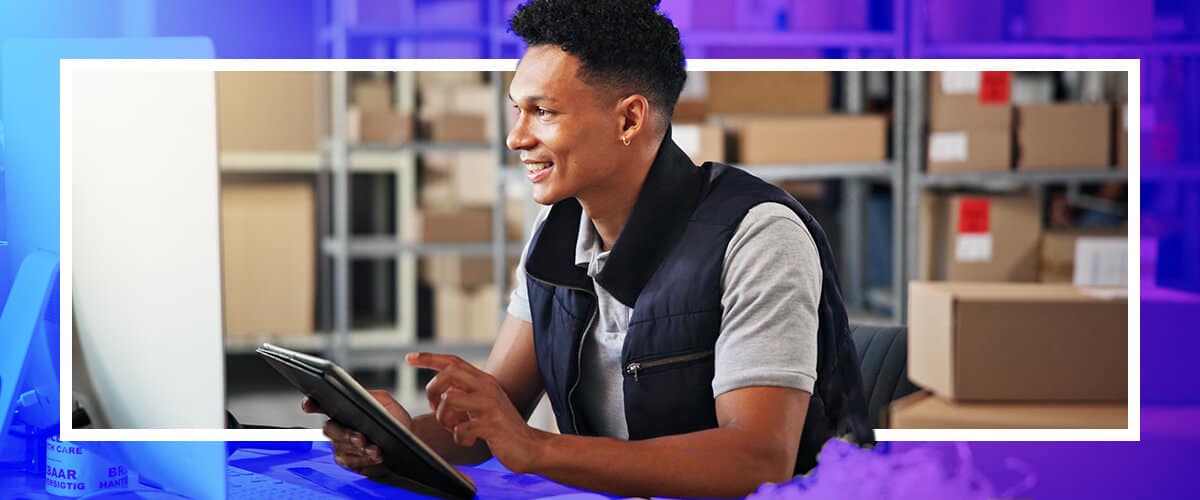Getting into or scaling within the fulfillment industry, however, doesn’t come without its share of costs. Whether it’s shipping, storage space, training employees, or purchasing the right warehousing technology, the costs associated with efficient order fulfillment can add up fast, and accurately calculating them all can be a challenge.
This guide will show you how to use a third-party logistics (3PL) cost calculator to estimate your order fulfillment expenses. You’ll see how important it is to size up your 3PL expenses correctly, and just how much incorrect 3PL cost calculation can eat into your profitability. We’ll also showcase how partnering with the right 3PL partner, like Logiwa, can boost operational efficiency and reduce costs.
Understanding the importance of 3PL cost estimation
Just as running a budget helps you keep track of where your money is going, using a 3PL cost calculator lets you map out your fulfillment expenditures. 3PL cost calculators can reveal which parts of your inventory management processes are eroding your bottom line, and give you an idea of how you can streamline your operations. That way, you can conduct a more accurate cost analysis and maximize your profits with each order you fill.
Key factors influencing 3PL pricing
From warehousing and labor to technology and shipping, both in-house and 3PL order fulfillment come with a wide range of expenses. That’s because both in-house and 3PL processes are highly resource-intensive, but the exact expenses can vary with each company’s needs. The question is: which route is most cost-effective for you?
To answer this question, first take an inventory of all the cost components that go into completing your order fulfillment in-house. Some factors to include are:
- Equipment: Packaging materials, barcode scanners, pallets and forklifts, 3PL fulfillment software
- Storage space: Utilities, maintenance, construction
- Labor: Wages, training, benefits, injuries
- Shipping: Carrier rates, tariffs, postage
- Materials: Raw materials, damaged inventory
- Customer services: Reverse logistics, product customization
Once you’ve accounted for your in-house fulfillment expenses, the next step is to consider the main components of a 3PL pricing model. Here are some common components to consider when calculating 3PL shipping costs, along with some industry averages:
- Account/setup fees: The one-time cost of creating a new account for you as a new customer
- Receiving fees: The cost of handling incoming inventory and assigning it to the proper place in the warehouse
- Pick and pack fees: The cost of picking new orders from storage and packing them so that they’re ready for shipping
- Storage fees: The cost of storing products in the warehouse
- Reverse logistics fees: The cost of returning a product from the consumer, and if possible, placing it back on the shelf for resale
Once companies evaluate these and other 3PL pricing factors, they can decide whether it makes more sense to complete their order fulfillment workflows in-house or outsource them to a 3PL partner.
Unlock a personalized tour of Logiwa IO
How to use a 3PL cost calculator
While a quick comparison can give you some idea of where you can save, a 3PL cost calculator helps you quantify your shipping costs for each route. A quality 3PL fulfillment software solution will guide you through the process of inputting your fulfillment data, but some steps to follow as you use your 3PL cost calculator are:
- Establish an interval over which you’ll analyze your shipping costs.
- Estimate your order volume based on historical data.
- Determine your average storage needs.
- Enter the required data according to the 3PL cost calculator’s prompts.
While the process of using a 3PL cost calculator is straightforward, there are some common mistakes to avoid. For example, some vendors may consider direct expenses for in-house fulfillment, such as order processing, storage fees, or shipping costs, but they may neglect indirect expenses such as lost sales opportunities from having to focus on their fulfillment operations.
Scalability issues are another indirect cost, as obtaining additional storage space, hiring more labor, or purchasing new equipment can all prove challenging during peak season — and all when vendors should be focused on fulfilling new orders to grow their brand.
How 3PL providers determine their rates
Understanding how 3PL providers calculate their rates can help you decide if 3PL or in-house fulfillment is best for your operations. Volume and frequency are two main factors considered in the 3PL cost calculation, as high-volume clients with fast-moving inventory require more fulfillment services, such as more space and improved handling, than startups.
Specialized services such as kitting, assembly, or personalization may also incur custom pricing, so it’s important to double-check the prices for value-added services like these before you choose a specific 3PL provider. It may be tempting to forego these add-ons to obtain extra savings, but they often serve as key 3PL services for revenue generation, so the investment is more than worthwhile.
Advanced tips for optimizing 3PL costs
Storage and utility costs, employees, technology — these are just a few of the direct costs associated with in-house ecommerce fulfillment. Companies must also consider indirect expenses, such as lost sales opportunities and product development.
3PL providers possess the storage facilities, personnel, equipment, and expertise needed to efficiently manage your order fulfillment processes, and they also enjoy carrier and packaging discounts that pass further savings onto you. For many companies, that means using a 3PL results in lower fulfillment costs, maximizing their profitability while lightening their workload by taking their order fulfillment processes off their hands.
Logiwa provides a Fulfillment Management System (FMS) platform that goes beyond legacy warehouse management capabilities. The result for growth-minded 3PLs and high-volume brands is faster and more efficient order fulfillment and a boost to your bottom line.
Finding a 3PL cost calculator you trust
To assist in the preliminary analysis, several companies provide free online tools. It is critical to differentiate these tools by their function: some are simple “ballpark” estimators, others are deep-dive comparison spreadsheets, and some are specialized tools that only calculate one part of the fulfillment process. When you are comparing 3PLs a good place to start is by searching on their site for “3PL cost calculator”.
Check out our cloud-based 3PL software today and see how it can help you streamline your order fulfillment processes.
FAQ about 3PL costs
What is a 3PL cost calculator?
What are the main components of 3PL pricing?
- One-Time Fees: Such as initial account setup or integration fees for connecting your ecommerce platform to the 3PL’s software.
- Receiving Fees: A charge for accepting, inspecting, and storing new inventory as it arrives at the warehouse. This is often billed per hour, per pallet, or per unit.
- Storage Fees: The recurring monthly cost for the space your inventory occupies. This is typically calculated by the pallet, per bin, or by cubic foot.
- Pick and Pack Fees: A fee charged for the labor of “picking” items from shelves and “packing” them for shipment. This is often billed as a base fee per order, plus a small fee for each additional item in the order.
- Shipping Costs: The cost to mail the package to the end customer. 3PLs often pass on their negotiated volume discounts from carriers like UPS, FedEx, and USPS.
- Reverse Logistics (Returns): A fee for processing customer returns, which includes inspecting the item, restocking it, or disposing of it.
- Account Management Fees: A recurring monthly fee to cover customer support, technology access, and general account overhead.
What are the most common 3PL pricing models?
- Transaction-Based (Activity-Based): You pay per action. Each service (receiving, storage, picking, packing) is billed as a separate line item. This model is highly transparent and common for ecommerce businesses with fluctuating order volumes.
- Fixed-Rate (Flat-Rate): You pay one predictable monthly fee that bundles all or most standard fulfillment services together. This is best for businesses with very stable and predictable order volumes.
- Cost-Plus: You pay the 3PL’s total direct costs (labor, rent, materials) plus a pre-negotiated markup (the “plus”). This is more common for large, enterprise-level clients with complex, high-volume needs.
- Hybrid Models: Many 3PLs use a combination, such as a fixed monthly fee for storage and account management, plus a transaction-based fee for pick-and-pack services.
What are typical 3PL costs for an ecommerce business?
- Initial Setup: $150 – $500 (one-time fee)
- Storage: $15 – $40 per pallet per month, or $0.45 – $0.75 per cubic foot per month
- Pick and Pack: $2.50 – $5.00 per order (this often includes the first item)
- Returns Processing: $3.50 – $5.00 per return
- Account Management: $75 – $500 per month, though many 3PLs bundle this into their other fees.
What "hidden fees" should I look for in a 3PL contract?
- Long-Term Storage Fees: Penalties for inventory that doesn’t sell and remains in the warehouse beyond a set period (e.g., 60 or 90 days).
- Dimensional (DIM) Weight Surcharges: Carriers charge based on a package’s size, not just its weight. If your 3PL uses unnecessarily large boxes, your shipping costs can inflate.
- Oversized or Heavy Item Fees: Surcharges for items that are unusually large, heavy, or require special handling.
- Peak Season Surcharges: Many 3PLs add extra fees during the busy holiday season (typically November-January) to cover higher labor and shipping costs.
- Minimum Volume Commitments: Some contracts include a “monthly minimum,” meaning if your fees don’t reach a certain dollar amount, you are billed the difference.
How can I reduce my 3PL fulfillment costs?
- Optimize Packaging: Work with your 3PL to use the smallest possible box for your products. This “right-sizing” avoids dimensional weight surcharges, which can be a major cost.
- Improve Inventory Turnover: Actively manage your stock to avoid long-term storage fees. Use promotions or sales to clear out slow-moving inventory before it incurs penalties.
- Consolidate Inbound Shipments: When sending new inventory to your 3PL, try to consolidate shipments onto fewer pallets to reduce inbound receiving costs.
- Provide Accurate Forecasts: Giving your 3PL a reliable forecast, especially before peak season, helps them plan labor and resources, which can prevent you from incurring rush fees or surcharges.





